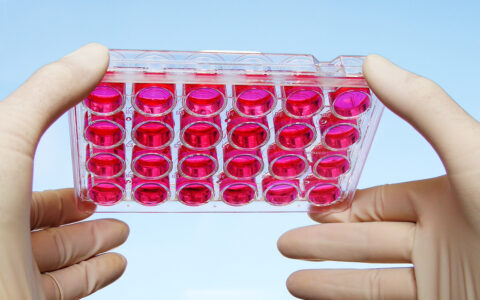Researchers at Vanderbilt University Medical Center have uncovered new insights into the structure and function of collagen IV, a major architectural element of the glomerular basement membrane (GBM). Diseases of the GBM, such as diabetic nephropathy, Alport syndrome and Goodpasture’s disease, are a key cause of chronic kidney failure and represent an unmet medical need.
Billy Hudson, Ph.D., Elliot V. Newman Professor of Medicine at Vanderbilt, and colleagues have studied how the collagen IV scaffold enables the GBM to function as a semipermeable filter and how structural alterations cause GBM dysfunction. Their findings, published in three parts (1, 2, and 3) in the Journal of Biological Chemistry, suggest that collagen IV is a promising target for therapeutic intervention.
“Currently, there are no therapies available for treating the cause of GBM diseases. We believe that collagen IV is a promising target for the development of drugs and gene editing therapies,” Hudson said.
Collagen IV
Collagen IV, one of the most abundant molecules within the GBM, is comprised of a family of six homologous but genetically distinct α-chains. Designated α1 to α6, the six α-chains undergo an intricate self-assembly process to ultimately form a complex network. This begins with the organization of the α-chains into hexamers with three distinct compositions: α121, α345, and α565. In turn, the hexamers organize into three supramolecular scaffolds, referred to as collagen IVα121, collagen IVα345, and collagen IVα556. Both collagen IVα121 and collagen IVα345 comprise the GBM.
“We believe that collagen IV is a promising target for the development of drugs and gene editing therapies.”
The collagen IVα345 scaffold is structurally altered in Alport syndrome. Hundreds of genetic variants are now known in COL4A3, COL4A4, and COL4A5 – the genes for the collagen IVα345 molecule – and these pathogenic variants underlie GBM abnormalities that result in a wide range of glomerular phenotypes in millions of people with Alport syndrome around the globe.
Discovery of the COL4A3 Variant
“Our research was driven by two key questions: ‘How does the collagen IVα345 scaffold facilitate GBM function?’ and ‘How do these plethora of gene variants contribute to renal failure?’” Hudson explained.
In their first report, the researchers discovered a common genetic variant in the COL4A3 gene in both a familial Goodpasture’s disease case and four Alport syndrome kindreds. A knock-in mouse model harboring the COL4A3 variant displayed GBM abnormalities and pathology that resembled Alport syndrome. The findings highlight a key role for collagen IVα345 in GBM function and dysfunction.
Structure and Function
In their second report, Hudson and colleagues also solved the crystal structure of the α345 hexamer, which revealed a surface marked by multiple pores and crevices that may be accessible to small molecules. The α345 hexamer structure will serve as a platform to decipher how variants cause Alport syndrome, as well as other GBM diseases.
A functional framework for α345 hexamer assembly was proposed in the third report. The researchers found that chloride ions promote hexamer assembly and stabilization, and that bioactive sites of the α345 hexamer demonstrate conformational plasticity. This insight suggested to Hudson and his team that genetic variants in collagen genes may interfere with hexamer assembly steps, including the proper conformation of the bioactive sites.
“Restoration of the native conformation of bioactive sites and α345 hexamer replacement are future approaches to therapeutic intervention,” Hudson said.
Future Directions
Collectively, these discoveries may assist in the design of therapeutic strategies for Alport syndrome and other GBM diseases. In particular, because the GBM is directly accessible to protein delivery via the bloodstream, modulation or replacement of the α345 hexamer could serve as a potential treatment for GBM diseases.
“Our recent discoveries represent a decade of work by an international team of 40 scientists, and we’re excited about the potential for future therapies targeting the α345 hexamer,” Hudson said.





